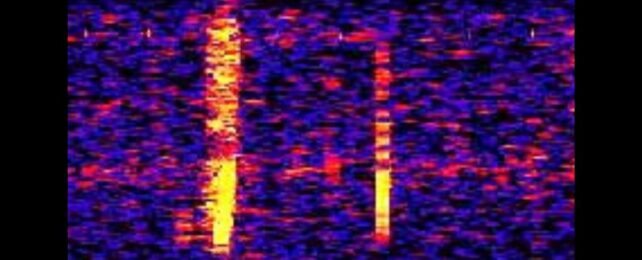In 1997, a deep belch echoed through the belly of Earth's oceans. The super low-frequency sound came out like a sliding 'bloooop'.
For years, it remained the loudest unidentified noise ever recorded underwater.
Scientists called it the Bloop.
Theories on where the eerie sound came from have since abounded. Perhaps it was the noisy product of underwater military exercises or ship engines. Some even suspected it might be a deep sea creature.
The sound of the Bloop undulates in frequency, making it slightly reminiscent of whale noises, but was detected by two arrays of hydrophones over a range at least 5,000 kilometers (about 3,100 miles). To travel that far, the unidentified noise must have been really loud – far too loud to emanate from a single underwater animal.
Besides, even though the Bloop sounds bloop-y when it's played back, the unmodified recording is 16 times slower, which means it is more like rolling thunder than an expulsion from some great beast.
Using the location of the hydrophones, researchers at the United States National Ocean and Atmospheric Agency (NOAA) could only narrow down the location of the Bloop to somewhere off the southern coast of Chile in the Pacific ocean.
Over the years, as researchers at NOAA deployed more hydrophones ever closer to Antarctica, they unwittingly drew closer to the Bloop's origin.
"It was there, on Earth's lonely southernmost land mass, that they finally discovered the source of those thunderous rumbles from the deep in 2005," reads a retelling on the NOAA website.
"The Bloop was the sound of an icequake – an iceberg cracking and breaking away from an Antarctic glacier!"
In recent years, new hydrophones operated by NOAA have recorded similar noises to the Bloop in the southern ocean and the Atlantic, sounds that were also made by icequakes.
The findings in Antarctica, collected between 2005 and 2010, confirmed what many scientists had suspected all along.
Oceanographer Chris Fox from NOAA told Richard Stenger at CNN as early as 2001 that he thought the Bloop was likely from chunks of ice calving in Antarctica, and he was right.
By 2012, seismologist Robert Dziak told WIRED's Ian Steadman that NOAA's hydrophones pick up on tens of thousands of Bloop-like sounds in the ocean every year.
While there are still some underwater recordings that remain a mystery, many odd sounds, including the Julia, the Slow Down, and the Train, have recently been explained by the movement of ice in the southern seas.
As ice loss in Antarctica accelerates beyond what scientists ever expected, over half the shelves holding up the Southern Hemisphere's ice sheet are nearing collapse.
Huge chunks the size of London are already breaking off, and scientists say icequakes are becoming more common with climate change.
Like bubbles popping in a boiling pot, the sound of bloops is building.
